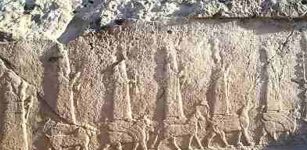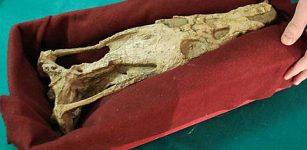Yokai Kitsune: Charming And Cunning Liar With Double Nature In Japanese Folklore
A. Sutherland - AncientPages.com - One of the most important and famous figures in Japanese mythology is Kitsune (‘fox’).
‘Kitsune’ is included in a large group of creatures known as Yokai (yōkai – demons, goblins, spirits, apparitions, leprechauns,) that are feared, admired, and worshiped almost as deities.
These demonic entities are believed to belong to the supernatural world, and they move between their world and the real one. Supernatural forces inhabit virtually every piece of their country, and they have shaped the Japanese culture.
Can We Consider Kitsune As Good Beings?
It seems we can, but we have to be very cautious because kitsune, like many other Yokai, has a dual nature.
Kitsune is a charming and cunning liar that can demonstrate the benevolent nature as a guardian or a devoted companion, and another time tends to misbehave.
But we must not forget that kitsune can easily show the other side of its nature, which is elusive and ruthless. Kitsune likes mischief, pranks and can become a dangerous shapeshifter or soul-possessed enemy demon.
Ancient Japanese literature, historical sources, and local folk tales indicate that this creature exists and represents two opposing aspects of the world, the good and the evil.
You can admire and worship the kitsune, but please remember that the kitsune symbolizes the laws of nature. Therefore, for your own safety, you must also keep a certain distance to it and fear it, too.
Kitsune And The Deity Inari
In the beliefs of the Japanese people, some of the most prominent kami are Amaterasu, Izanagi, Izanami, Susanoo, and Inari, the Shinto deity.
Inari in the Japanese beliefs is the kami (a spirit with holy powers) of the rice fields, and it existed since at least the Nara period (710–784 AD) and had many other responsibilities as a deity of fertility, farming, fishing, cultivation, productivity, prostitution, and the martial art.
A connection between Inari and kitsune has started about the 11th century. This significant cult has about forty thousand shrines scattered across Japan, all decorated with images and statues of these holy foxes guard the entrances to the deity’s temples.
As divine messengers of Inari, they act as a bridge between the human and celestial worlds.
Many early Japanese tales of kitsune can be traced back to China, where the creature was also known for its shape-shifting talents, most notoriously taking on the guise of beautiful, seductive women. Still, they could also suddenly emerge as an older man.
Divinity And Colors of Foxes
In folk beliefs, most kitsune can be red, black, gold, and silver (or white). But not only white (silver) Inari foxes had an aspect of divinity.
Kinko and Ginko (gold and silver kitsune) are two in one as a unity, and incarnation of Yin-Yang dualism. While Kinko is the manifestation of Yin representing the Sun, Ginko, on the other hand, is the manifestation of Yang representing the Moon.
On their backs, they carried the Buddhist goddess Dakini (sacred female spirit in Hinduism and Vajrayana Buddhism).
A white fox – usually understood as a harbinger of death was also Dakini’s private messenger.
Kitsune Likes To Feed On Life Energy Of People
According to mythology, Kitsune (known by different regional names) is a multitalented spirit mentioned in the earliest Japanese texts.
 Statue of kitsune at Inari Temple in Tōdaiji in Nara, Japan. Source
Statue of kitsune at Inari Temple in Tōdaiji in Nara, Japan. Source
Mythological sources confirm two types of kitsune: the ‘zenkos,’ also known as ‘Inari Foxes,’ who are the deity’s messengers; the second group represents ‘yako’ (wild foxes) that can be bad and even evil, and associated with chaos. They are said to feed on the life energy of people or their spirits.
They had transformation ability and most often took the form of a beautiful young woman or monk. However, the length of the transformation was dependent on the age of kitsune. Foxes that were at least five hundred years old could last in any form for a very long time.
Young, inexperienced kitsune could not wholly transform, and their tails were often sticking out from under their clothes.
See also:
Nurikabe: Trickster That Manifests Itself As Invisible, Impassable Wall In Japanese Old Beliefs
Demon Oni: Cruel Harbinger Of Disease And Misfortune In Japanese Folklore
In the ‘Nihonshoki’ - the first official source of history of Japan, and even an essential reference for Japanese myth – the creatures appear as omens, either good or bad.
It sometimes happened that their malice was so painful that as a consequence, the creatures led the unfortunate person to mental illness and even death.
In Japanese mythology, the fox could have another tail every hundred years, and those who have lived for a thousand years had as many as nine tails and possessed the ability to see as far as possible.
The more tails a kitsune has, the older, wiser, and more powerful it is.
Kitsune And Good Harvest
An ancient belief says that farms that always were successful with a good harvest must have any unique association with foxes, which in some way, could contribute to the people’s wealth. These people were believed to be the so-called ‘kitsune-mochi families’ (the owners of kitsune. In consequence, they were protected by yokai spirits, who cared for the family’s good harvest and wealth of the household and warded off evil spirits.
Because of their potential power and influence, some people make sacrifices to kitsune as to a deity by offering fried soybean curd at Inari shrines, a food, which is a favorite of foxes.
Written by – A. Sutherland - AncientPages.com Senior Staff Writer
Copyright © AncientPages.com All rights reserved. This material may not be published, broadcast, rewritten or redistributed in whole or part without the express written permission of AncientPages.com
More From Ancient Pages
-
 Ten Inscriptions Related To Sargon Unearthed At Ancient Assyrian Site In Iraq’s Kurdistan Region
Archaeology | Jan 20, 2020
Ten Inscriptions Related To Sargon Unearthed At Ancient Assyrian Site In Iraq’s Kurdistan Region
Archaeology | Jan 20, 2020 -
 4,000-Year-Old Funerary Garden Found In Luxor, Egypt
Archaeology | May 9, 2017
4,000-Year-Old Funerary Garden Found In Luxor, Egypt
Archaeology | May 9, 2017 -
 How Ancient Cultures Explained Comets And Meteors
Archaeoastronomy | Jun 5, 2019
How Ancient Cultures Explained Comets And Meteors
Archaeoastronomy | Jun 5, 2019 -
 Grave Of Amazon Warrior Who Lived In The Kingdom Of Urartu Discovered In Armenia
Archaeology | Nov 28, 2019
Grave Of Amazon Warrior Who Lived In The Kingdom Of Urartu Discovered In Armenia
Archaeology | Nov 28, 2019 -
 Maat – Ancient Egypt’s Most Important Religious Concept
Egyptian Mythology | Apr 4, 2018
Maat – Ancient Egypt’s Most Important Religious Concept
Egyptian Mythology | Apr 4, 2018 -
 3,400-Year-Old Cuneiform Tablet Excavated In Old City Of Alalah
Archaeology | Aug 23, 2020
3,400-Year-Old Cuneiform Tablet Excavated In Old City Of Alalah
Archaeology | Aug 23, 2020 -
 10,000-Year-Old Seeds Offer First Evidence Of Farming In A Green Sahara
Archaeology | Mar 19, 2018
10,000-Year-Old Seeds Offer First Evidence Of Farming In A Green Sahara
Archaeology | Mar 19, 2018 -
 Ancient DNA And Tombstones Lead Scientists To Black Death’s Source Strain
Archaeology | Jun 15, 2022
Ancient DNA And Tombstones Lead Scientists To Black Death’s Source Strain
Archaeology | Jun 15, 2022 -
 Revealing 1,200 Years Of Arctic Canadian Cultures And Settlements In Canada
Archaeology | Jul 11, 2024
Revealing 1,200 Years Of Arctic Canadian Cultures And Settlements In Canada
Archaeology | Jul 11, 2024 -
 Archaeologists Discover Long-Lost Scottish Monastery Of Deer And Solve An Old Manuscript Mystery
Archaeology | Nov 21, 2023
Archaeologists Discover Long-Lost Scottish Monastery Of Deer And Solve An Old Manuscript Mystery
Archaeology | Nov 21, 2023 -
 Machu Picchu Was Built With The Royal Unit System – New Research Suggests
Archaeology | Jan 14, 2021
Machu Picchu Was Built With The Royal Unit System – New Research Suggests
Archaeology | Jan 14, 2021 -
 Magical Dinas Emrys: Legendary Battle Of The Dragons And Merlin’s Hidden Treasure
Featured Stories | Jan 15, 2025
Magical Dinas Emrys: Legendary Battle Of The Dragons And Merlin’s Hidden Treasure
Featured Stories | Jan 15, 2025 -
 On This Day In History: Great Fire Of London Ends – On Sep 5/6, 1666
News | Sep 5, 2016
On This Day In History: Great Fire Of London Ends – On Sep 5/6, 1666
News | Sep 5, 2016 -
 Livestock And Dairying Led To Dramatic Social Changes In Ancient Mongolia – New Study
Archaeology | May 11, 2022
Livestock And Dairying Led To Dramatic Social Changes In Ancient Mongolia – New Study
Archaeology | May 11, 2022 -
 Artificial Intelligence And Clay Tablets: Not Yet A Perfect Match
Scripts, Paintings & Inscriptions | Oct 12, 2023
Artificial Intelligence And Clay Tablets: Not Yet A Perfect Match
Scripts, Paintings & Inscriptions | Oct 12, 2023 -
 Oldest Carving Of A Penis Discovered On Ancient Mongolian Pendant
Archaeology | Jun 20, 2023
Oldest Carving Of A Penis Discovered On Ancient Mongolian Pendant
Archaeology | Jun 20, 2023 -
 DNA Sheds Light On The Iron Age Log Coffin Culture In Pang Mapha, Thailand
DNA | May 20, 2024
DNA Sheds Light On The Iron Age Log Coffin Culture In Pang Mapha, Thailand
DNA | May 20, 2024 -
 More Than 1000 Bones Of Extinct Predators From 240 Million Years Ago – Found In Upper Silesia, Poland
Fossils | Dec 11, 2023
More Than 1000 Bones Of Extinct Predators From 240 Million Years Ago – Found In Upper Silesia, Poland
Fossils | Dec 11, 2023 -
 Cog Stones – Unusual Stone Discs Made By An Ancient Lost Civilization In California
Artifacts | Jan 4, 2018
Cog Stones – Unusual Stone Discs Made By An Ancient Lost Civilization In California
Artifacts | Jan 4, 2018 -
 Biblical City In Zanoah Offers Archaeological Evidence Of Moses’ Journey To The Promised Land
Archaeology | Jul 18, 2024
Biblical City In Zanoah Offers Archaeological Evidence Of Moses’ Journey To The Promised Land
Archaeology | Jul 18, 2024


